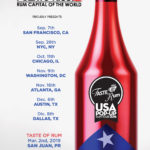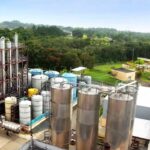What I learned while visiting Puerto Rico
On April 12, 2023 a livestream started on the “ZAVVY” platform. The livestream was hosted by “The Rum Lab” with the participation of Fede J. Hernandez, entrepreneur specialized in sales and marketing and as a guest Bryan Inman from “The Rum Champion” who will share with us his experience visiting the island of Puerto Rico during its National Rum Festival – Taste of Rum.
A Memorable Journey to Puerto Rico’s Distilleries
Bryan Inman embarked on a fascinating journey to explore the distilleries of Puerto Rico. Upon landing in San Juan, located in the north, he was eager to head south to Ponce. The drive, which took approximately an hour and a half, was filled with anticipation and a pit stop for gas. More importantly, it was during this stop that Bryan discovered Palo Viejo, a rum distilled at Serrallés, the same distillery that produces Don Q. He likened the experience of sipping this rum from small packets to reliving the nostalgia of drinking from a Capri Sun packet, but with the added delight of a rum beverage.
The drive through the mountains was dark, yet the contours of the hills were discernible. Upon reaching Ponce, Bryan was struck by the stark contrast between the constant noise of Los Angeles, where he resides, and the profound silence of Ponce. The silence was so profound that even a cleared throat seemed to echo throughout the city.
Despite it being night, Bryan could appreciate the vibrant beauty of Ponce’s architecture and colorful buildings. After a restful night, he woke up to a sunny day and enjoyed breakfast at a local spot that had been converted from a Burger King.
The realization of his adventure truly hit him when he saw the building marked ‘Destileria Serrallés’. The excitement was palpable as he toured the distillery, especially since he had previously received six bottles from Don Q, including a Zinfandel cask. Being at the distillery felt like being a kid in a candy store for Bryan.
In summary, Bryan Inman’s journey to Puerto Rico’s distilleries was filled with anticipation, discovery, and an appreciation for both the silence of Ponce and the vibrant rum culture of Puerto Rico.
Immersive Experience at Puerto Rico’s Distilleries
Bryan Inman’s exploration of Puerto Rico’s distilleries offered him a wealth of knowledge and sensory experiences. One surprising revelation was that the distilleries were not temperature-controlled or air-conditioned. Instead, they were sealed, and the local climate and humidity played a crucial role in the rum-making process.
Entering the distilleries was an olfactory delight. The scent of rum aging in barrels was nothing short of remarkable. Each distillery had a variety of barrels, including cognac, double cask, Zinfandel, port, and sherry. As Bryan walked through the rows of barrels, he could detect subtle differences in aroma due to the influence of the spirit with which the rum interacted in each barrel.
The highlight of his visit was a table adorned with bottles of rum and tasting samples. Cordero, the master blender at Serrallés, challenged Bryan and his companions to create their own rum blends. This exercise was not only fun but also an opportunity for Cordero to gain fresh insights into potential new blends.
The blending process involved various rums with different aging properties and distillation methods. Bryan compared it to a chemistry class experiment as they used beakers and test tubes to mix their blends.
In conclusion, Bryan Inman’s visit to Puerto Rico’s distilleries was an enlightening journey filled with sensory experiences, learning opportunities, and the joy of creating his own rum blend.
Unveiling the Art of Rum Making in Puerto Rico
Bryan Inman’s journey into the world of Puerto Rican rum was an enlightening experience. He discovered that most Latin-style rums, especially those from Puerto Rico, are typically bottled at around 40% ABV. However, the cask strength rums he encountered during his visit were much stronger, with an alcohol content between 60 to 65%. These rums offered a robust flavor profile that defied the common perception of Puerto Rican rum as light and refreshing.
Serrallés Distillery, one of the places Bryan visited, uses two types of stills: a continuous column still and an older copper still. The copper still is used to produce heavier rums. The distillery also blends different rums and employs various processes depending on the type of rum being produced.
The distillation process begins in Florida, where the molasses are produced. The molasses are then transported to Puerto Rico in large tanks for distillation. This is a crucial step in producing authentic Puerto Rican rum.
At Club Caribe, another distillery Bryan visited, the finishing touches are added to the rum in Puerto Rico. The rum is passed through a four-column still process and also a copper still. The distillery also sells bulk rum that qualifies as Puerto Rican rum.
Bryan also had the opportunity to visit two aging warehouses. There, he met Judith, an energetic guide who showed him a barrel from December 18th, 2014 (barrel number 22). In the laboratory, Bryan was fortunate enough to taste four bottles of rum from the continuous column stills, all from the same 2014 batch. Upon request, Judith also brought in some rum from a copper still.
A Journey Through Puerto Rico’s Distilleries
The journey continued to Nikini, a massive distillery that also operates as a water company and a canning company for Coca-Cola. The distillery is also home to an art museum and features a miniature copper pot still used for experimental purposes.
Bryan Inman and Fede J. Hernández embarked on a tour of distilleries in Puerto Rico. Their journey began at the Caroni facility, where Louis Vuitton Moet Hennessy in Trinidad and Tobago were producing ten cane rum. However, the distillery was closed down, and the inventory was purchased by Pedro de la Cruz and Jose Pepe, two close friends. San Juan Artesian Distillery, owns two parcels of land.
The duo then traveled to Bacardi, where they participated in several tastings. Despite the 45-minute drive, they arrived sober but acknowledged the effects of the alcohol on their bodies. Their next stop was the Club Caribe laboratory, where Judith encouraged them to sample various cask strength rums directly from the pot or column still.
They also visited Cukurova distillery and Marcel Delgado, number three, where they have 132 barrels for the solera process. Interestingly, these barrels are made directly from aguardiente, a rum from Florida Distillers. This rum did not go through the four column stills like others.
Inman and Hernández noted that in Puerto Rico, rum was originally called aguardiente before it evolved into rum. They found it fascinating that aguardiente is no longer consumed in Puerto Rico and expressed their mission to promote it. They also mentioned that Bacardi uses a process of our D.A. in their blend, resulting in a stronger rum compared to other smoother and softer Puerto Rican rums.
Exploring the Richness of Puerto Rican Rum
Bryan Inman and Fede Hernandez shared their experiences from his visit to Puerto Rico. They began by expressing his surprise at the diversity and richness of the local rums, such as Bacardi Superior, Don Q Cristal, and Serrallés. They also noted that each brand had its unique style, making the Puerto Rican rum scene incredibly varied.
Inman and Fede highlighted the friendly rivalry among the rum producers on the island. Unlike in Los Angeles. They found that in Puerto Rico, producers view each other as rivals who push each other to improve. This approach, benefits everyone involved.
During his trip, Inman and Fede visited several distilleries across the island. One of these was Ron del Barrilito in Hacienda Santa Ana. Although their initial plan was to visit San Juan Artesian Distillery, they were unable to make it on time. Fortunately, they were able to tour Ron del Barrilito instead.
At Barrilito, Inman was particularly impressed by a cocktail made with coconut water ice cubes and Barrilito’s three-star rum. He found this combination so remarkable that he has been recommending it to everyone since his return to Los Angeles.
The Art of Rum Making: An Inside Look at Barrilito’s Distillery in Puerto Rico
Fede Hernandez and Bryan Inman recounted the story of Pedro Hernandez, the founder of Barrilito. Pedro, an engineering student in France, developed a love for cognac. Upon returning to Puerto Rico, he desired to produce cognac but was hindered by the lack of grapes at scale. Ingeniously, he decided to apply the cognac distilling process to sugarcane juice, leading to the creation of Barrilito three star.
Pedro’s passion for his creation was infectious. He would share his rum from a small barrel, or ‘barrilito’, leading people to return for more. This prompted him to consider producing his rum at a larger scale. Barrilito is believed to be one of the oldest rum producers on the island in terms of continuous production.
The company was one of the first in Puerto Rico to receive land from Queen and King Fernando for a sugarcane plantation. While they were not necessarily one of the first to open a distillery, they had land before many others as it was bestowed upon them.
The interviewees also shared their personal experience with Ron Del Barrilito four star. When purchasing a bottle, customers are given the option to bottle it themselves. Contrary to their expectations of a mechanized process, they found that each bottle is filled by hand. This hands-on experience made them appreciate the value of their $300 bottle of rum even more.
Not only do customers get to fill their own bottles, but they also get to coat it with black wax, adding a personal touch to each bottle. This unique experience has made their bottle of Ron Del Barrilito four star near and dear to their hearts.
Exploring the Art of Rum Making in Puerto Rico
Fede Hernandez and Bryan Inman, during their tour of Puerto Rican distilleries, visited San Juan Artisanal Distillers, known for their award-winning rum, Ron Pepon. This rum has been recognized by Ultimate Awards as the best unaged or aged 1 to 3 year rum.
San Juan Artisanal Distillers also produce “Tres Clavos”, a rum made in collaboration with the Dominican Republic using a sugarcane juice system. The distillery is also known for its variety of infused flavored rums, including Ginger Spice and Passion Fruit Parcha. These infusions are hand-placed into the bottles, creating a unique and flavorful product.
The tour continued to Casa Bacardi, one of the most renowned rum producers in the world. Despite some preconceived notions about Bacardi, the visit to Casa Bacardi completely changed their perspective. They were impressed by Bacardi’s commitment to quality and the financial investments made into their production process.
They had the opportunity to meet with Bacardi’s former global master distiller, Jose Gomez, and their current global master blender, Troy. The premium rums produced by Bacardi, including Ocho años and Diez años, left a lasting impression on them. They also appreciated Bacardi’s sherry cask and rye cask finishes.
Bacardi’s consistency in taste, regardless of where in the world it is consumed, was highlighted as a remarkable achievement. This consistency is a testament to Bacardi’s production capabilities, as they manufacture 90% of the world’s rum.
A Journey Through Puerto Rican Distilleries
Fede Hernandez and Bryan Inman were discussing the intriguing fact about Casa Bacardi’s 160-year-old yeast. This yeast is securely locked away, accessible only to a select few individuals. The yeast is so crucial that its transportation involves a security detail and a handcuffed briefcase, reminiscent of scenes from movies. This yeast is integral to the production of 90% of the world’s rum, making its security paramount.
They then proceed to describe their visit to a massive warehouse, which they compare in size to an American football field. The intensity of the smell upon entering the warehouse is overwhelming. As they venture further into the warehouse, they start feeling lightheaded due to the potent smells. They marvel at the sight of numerous barrels, each designed differently.
The question arises about how the distillery keeps track of all these barrels. It turns out there is an intricate system involving barcodes in place for this purpose. During their visit, they also had the opportunity to taste a few cask strength Bacardi’s, including a remarkable sherry cask finish at cask strength.
The interviewees then discuss a program initiated by Joe Gomez, the previous master distiller. This program involved dumping different barrels into smaller ones as a quick way to experiment with different types of rum and monitor their progression.
They also discuss how charcoal filtration affects rum. They explain that Puerto Rican rums, by law, have to be aged for a minimum of one year and hence come out with color. Through charcoal filtration, the color of the rum is removed while maintaining as much flavor as possible.
Finally, they share an interesting fact about the Bacardi family’s original distillery in Santiago de Cuba, which had a palm tree. This palm tree has become symbolic for the Bacardi family.
Exploring Puerto Rican Distilleries: A Glimpse into the World of Rum Production
In a captivating interview, Fede Hernandez and Bryan Inman share their experiences of visiting various distilleries in Puerto Rico. They discuss a unique program initiated by Joe Gomez, the previous master distiller, which involved transferring rum from larger barrels into smaller ones. This process allowed for quick experimentation with different types of rum and their progression.
They also delve into the process of charcoal filtration and its impact on rum. They explain that Puerto Rican rums, by law, must be aged for a minimum of one year, resulting in a gold-colored rum. Through charcoal filtration, the color is removed while retaining as much flavor as possible. This process is employed by several groups, including Serrallés, Garibay, and Bacardi in Puerto Rico.
The interviewees then share an interesting anecdote about the Bacardi family’s original distillery in Santiago de Cuba, which had a symbolic palm tree. The family believed that as long as the palm tree was healthy, they would prosper. When the tree fell, a new one was planted in Puerto Rico.
They also discuss their visit to La Catedral de Ron de Puerto Rico, inaugurated when Bacardi opened its distillery in Puerto Rico. They were able to explore the fermentation tanks and learn about the secure location where the yeast is stored.
The interview concludes with them expressing their admiration for the joyous spirit of the Puerto Rican people, especially those working in the distilleries. The interview provides a fascinating insight into the world of rum production and the meticulous processes involved.
Exploring Puerto Rican Distilleries: A Glimpse into the World of Rum Production
In a captivating interview, Fede Hernandez and Bryan Inman share their experiences of visiting various distilleries in Puerto Rico. They discuss a unique program initiated by Joe Gomez, the previous master distiller, which involved transferring rum from larger barrels into smaller ones. This process allowed for quick experimentation with different types of rum and their progression.
They also delve into the process of charcoal filtration and its impact on rum. They explain that Puerto Rican rums, by law, must be aged for a minimum of one year, resulting in a gold-colored rum. Through charcoal filtration, the color is removed while retaining as much flavor as possible. This process is employed by several groups, including Serrallés, Garibay, and Bacardi in Puerto Rico.
The interviewees then share an interesting anecdote about the Bacardi family’s original distillery in Santiago de Cuba, which had a symbolic palm tree. The family believed that as long as the palm tree was healthy, they would prosper. When the tree fell, a new one was planted in Puerto Rico.
They also discuss their visit to La Catedral de Ron de Puerto Rico, inaugurated when Bacardi opened its distillery in Puerto Rico. They were able to explore the fermentation tanks and learn about the secure location where the yeast is stored.
The interview concludes with them expressing their admiration for the joyous spirit of the Puerto Rican people, especially those working in the distilleries. The interview provides a fascinating insight into the world of rum production and the meticulous processes involved.





